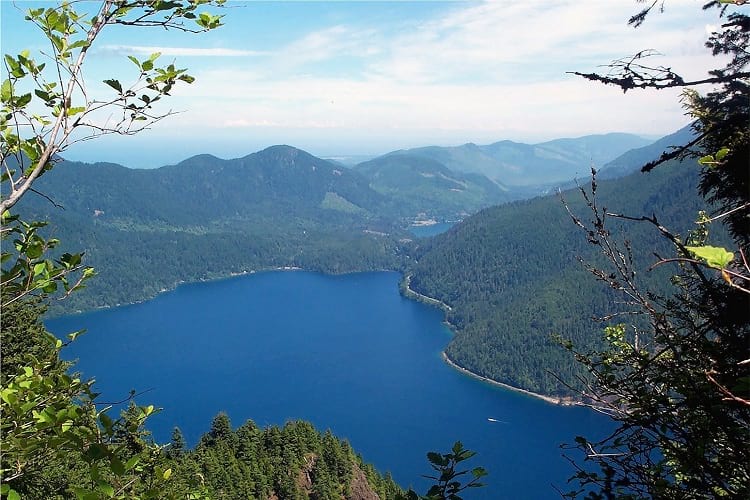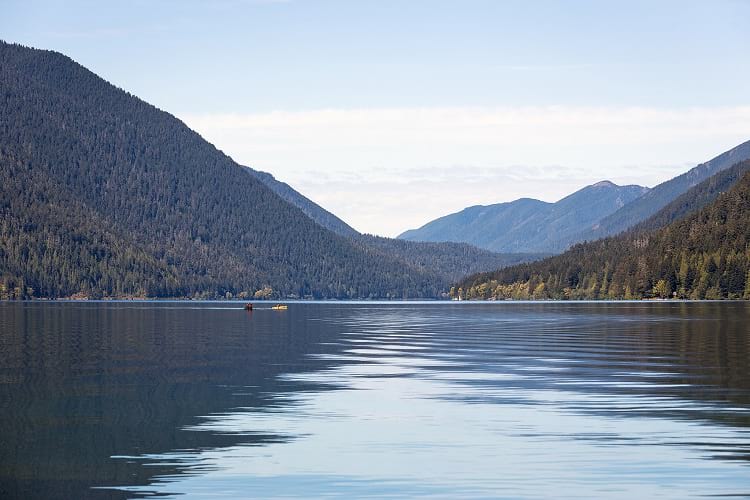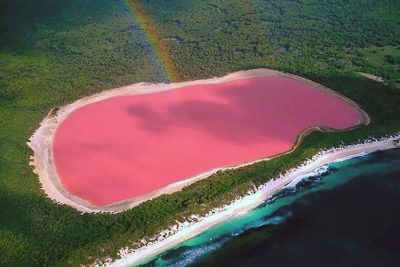Lake Crescent: Washington State’s Beautiful, Deadly Lake and its History of Chilling, Notable Incidents
Share

Lake Crescent, Washington, United States. (Elwhajeff / Wikimedia Commons)
Lake Crescent is one of the deepest lakes in the United States. It was formed by the melting of ice-age glaciers and is in the Olympic National Park in Washington State. An area of stunning natural beauty, it is popular with hikers, kayakers, sightseers, and fishermen. There is, unfortunately, also a dark side to the lake. Its icy waters have claimed many victims and, given its great depth, some of them were never found. As for the ones that did get found, it was only after many years had elapsed that the lake let up its secrets.
Lake Crescent
The first thing visitors notice about Lake Crescent is its pristine, blue waters. There is a high nitrogen content in the water, which prevents the growth of algae and that is the reason for the extreme clarity of the water. The lake, when seen from above, forms a rough crescent shape. It didn’t get its name for its shape though, but from the Port Crescent Improvement Company which was trying to set up a new town called Port Crescent in Clallam County in the late 1800s. As part of their efforts to attract prospective investors and townspeople to the new town, they started a local newspaper, the Port Crescent Leader, and described the natural environment around the town site. In this promotion, the lake, which earlier discoverers had named Lake Everett, became Lake Crescent and that is what it has been called ever since.

Outline of Lake Crescent. (Eian Ray / Wikimedia Commons)
Apart from the ice-cold waters, the lake has treacherous depths with silt beds and tiers of craggy cliffs. According to the National Park Service, the official depth of the lake is 624 feet. A depth of 1000 feet has also been recorded, however. In 2014, surveyors discovered that the previous depth measurements were in error and the deepest point of the lake measured 650 feet. The lake is spread across 5,127 acres and is 19 kilometres long. It is home to a variety of fish, notably the Beardslee trout and the cutthroat trout. These fish were once anadromous or migratory, but about 1000 years ago, a tremendous earthquake caused a landslide that dammed up the lake. The local Klallam tribe’s mythology describes this event, although they claim that the Mount Storm King caused the landslide to punish the Klallam and the Quileute tribes for fighting one another and disturbing the peace.

People kayaking at a distant in Lake Crescent. (Jonathan Miske / Flickr)
The Olympic Mountains stand guard around Lake Crescent. On clear days, there is an exceptional serenity to the environment that charms all visitors. You would not associate such a beauteous lake with any unpleasant undertones. There have, however, been several strange and notable events associated with the lake that cannot be ignored. They have given the lake a rather sinister reputation and you might very well believe it if you happen to see the lake in stormy weather, with the wind howling and the waves crashing wildly. It is almost as though it is lashing about in frustration, waiting for its victims to show up and be swallowed up in its deep, freezing waters.
Let’s look at some of the notable incidents that happened on Lake Crescent:
1929: The Warren Couple and their 1927 Chevrolet
On 3 July 1929, Russell Warren, 35, and his wife Blanch Warren, 33, were driving back to their home in a logging camp on the Bogachiel River from Port Angeles. The route they took was the narrow, dirt road skirting along Lake Crescent. Blanch Warren had been hospitalized for some unknown ailment in Port Angeles and Russell had driven there to fetch her back. Along with picking up his wife, Russell Warren paid a $100 outstanding grocery bill, made the latest instalment payment on his car, and bought a washing machine that he put in the back of the car. The couple was looking forward to celebrating the US Independence Day on 4 July the following day. They had made plans to visit the Sol Duc Hot Springs with their two boys, Charles and Frank, aged 11 and 13 respectively. The boys were home alone, with only $35 for any emergencies that might crop up while their parents were away.
The Warrens never reached home. They and their 1927 Chevrolet vanished without a trace. Two weeks later, on 16 July 1929, the Port Angeles Evening News reported that the couple was missing, and the local sheriff conducted a two-month-long investigation. They found car skid marks, broken glass, and a cap that belonged to Russell Warren at Madrona Point near the lake; it was called Madrona Point because a Madrona tree in the nearby hills was visible from the location. The investigators dredged up Lake Crescent and sent divers to search the depths of the icy waters, but with the diving equipment that was available at the time, the divers could only go down to a depth of 78 feet. They were unable to find anything trace of the missing couple. An eyewitness stepped up to say that he had seen a car crash into the lake, but it turned out, that accident had happened two weeks after the Warrens disappeared.
After an extensive search that produced no results, people began to doubt that there might have been an accident. Perhaps the couple had just abandoned their children and taken off somewhere. Friends and family of the Warrens dismissed this as unlikely. They were not the type of people to do such a thing. The doubts lingered on though and their own sons were affected by the rumours.
For the next 73 years, the whereabouts of the Warrens remained a mystery. Their sudden and unexplained disappearance devastated their sons and scarred them for the rest of their lives. They were sent to live with their maternal grandmother in Montana, but that did not work out. Frank soon ran away, and Charles left too shortly afterwards. They did not get along with each other and went their separate ways and did not keep in touch for many years. Both came to tragic ends. The elder son, Frank, became an alcoholic and died of pulmonary congestion and oedema at the age of 57 in Maple Valley in 1972. The younger son, Charles, disappeared on 14 June 1964 when his fishing boat, a 35-foot Mildred G, collided with another vessel in a fog and sank off the coast of Northern California in 1964. He was 47 years old when he vanished. Their surviving families believed what they and everyone did for a long time, that their callous and uncaring parents had left them to fend for themselves.
Then, in 2002, volunteer divers and a search team from the National Park Service discovered their 1927 Chevrolet at a depth of 166 feet at the west end of Lake Crescent. They found the vehicle to be in intact condition. It was lying on its left side, on a steep slope, some 60 feet away from the lake shore near Ambulance Point on U.S. Route 101. The bodies of the couple were not found. It is assumed that they lost control of the car and hurtled off the dirt road and fell into the lake. The road, incidentally, is now higher than it was in 1929 and has been fitted with safety guard rails.
The Warrens’ great-granddaughter, Kristine Coachman, 32, thanked the divers and the search team for clearing up this disturbing part of their family history. The search efforts were conducted over a period of 11 months by district ranger Dan Pontbriand. The overseer of the 144,000-acre Olympic National Park, became intrigued with the case after he heard the story from Bob Caso, a local man. Since it seemed more likely to him that the Warrens had met with a bad end in Lake Crescent rather than have left their sons in such an abrupt manner, Pontbriand decided to investigate the matter. The search team was aided by Gene Ralston who used a side scan sonar to search in the lake. This tool is attached to the back of a boat and dragged in the water. The sound waves it emits bounce off objects in the lake’s depths and their locations are marked so that they can be examined later. The searchers found several cars, some of which were Ford Model A vehicles, in the lake. It was puzzling. Had there been so many car accidents in the lake? Then they heard that a carjacking gang had been stripping and dumping cars in the lake in the 1930s and, more probably than not, these cars were their handiwork.
After pinpointing the car’s location, the team sent in divers and they finally found the car.
The relieved Warren family and their relatives requested the car to be left in the lake as a fitting resting place for the couple.
1940: Hallie Illingworth – Lady of the lake
In June 1940, a woman’s body was discovered floating in the lake. The body had a rather strange white colouration and the face was no longer identifiable and the skin on the fingertips had worn away. Other than that, the freezing lake waters had preserved it in near perfect condition. The loss of the facial features and fingerprints clearly pointed to the body’s having been submerged in Lake Crescent for a very long time. The woman had once been tethered to weights that had kept her underwater, but the ropes had frayed away over time. The body had then been pushed up to the lake surface. The whiteness of the body, it turned out, was the result of saponification. The chemicals in the lake waters had reacted with the woman’s body fat to turn her skin into soap.
A further examination of the body revealed the woman had been strangled to death. There were also bruise marks on the body.
At first, nobody knew who the woman was, and, since forensic science wasn’t as advanced then as it is now, there seemed little way of finding out. The only clue was a dental plate that was found on the corpse. Deciding to see where that lead, Hollis B. Fultz, the criminal investigator on the case, published photographs of the dental plate in several dental magazines and asked if anyone had any information about it. A dentist from South Dakota saw the photographs and recognized the dental plate as one that he had himself made a few years earlier. A look through his records came up with her name. She was Hallie Latham Illingworth, originally from Kentucky, and she had moved to Washington for better work and life prospects. Here, she had worked as a waitress at a local tavern, had married for the third time, and had then abruptly gone missing in December 1937. When her family had inquired about her whereabouts, her third husband, Montgomery Illingworth, had informed them that she had eloped to Alaska with a new lover, a sailor. He had filed for a divorce five months afterwards and had remarried and moved to California.
Now that the body was conclusively identified as hers, the police contacted her ex-husband Montgomery Illingworth, a former beer truck driver, who denied it was his wife. Their neighbours and friends, however, identified the clothes as hers. They also informed the police that the couple had been prone to having frequent wild and violent fights and that Hallie Latham Illingworth had often sported bruises from being beaten up by him. On several occasions, the neighbours had to summon the police to intervene and stop the fights. A search through the husband’s place led the researchers to find a rope whose strands matched those of the rope that had been used to bind the dead woman. It became clear that the husband had murdered his wife during one of their fights and had chosen to dispose of her body in Lake Crescent.
The police arrested Montgomery Illingworth and he was put on a jury trial in Port Angeles. He continued to first deny that it was his wife and then deny any involvement with his wife’s death, but the evidence against him was too strong. The jury pronounced him guilty of second-degree murder in 1942 and he was sentenced to life imprisonment. He served nine years at the Washington State Penitentiary in Walla Walla until he was paroled in 1951. He died in 1974 in California.
1956 & 1960: Ambulance Point on Lake Crescent
This location on the lake got its name after an ambulance swerved off the road and hurtled into the water on 27 August 1956. The ambulance was from a hospital in Port Angeles and was returning after picking up an injured lumberjack in Forks. The lumberjack, a man named Ernest Monroe Dahlgren, had broken his leg and was strapped on to the gurney to protect him on the journey to Port Angeles. Unfortunately, this turned out to be a fatal aspect for him. Since he was tied down in this manner, he was unable to escape the ambulance after it crashed into the water. He went down into the lake depths with it. The two medics accompanying him were able to get out in time.
There was another incident at Ambulance Point on 24 January 1960, when a Dodge sedan skidded on the icy road and plunged into Lake Crescent. The car belonged to a man named Dan Steele and he had three other people with him in the car. They all managed to escape the would-be watery grave and swam safely to the shore. One of them, Beverley Sherman, when she heard about the discovery of the Warrens’ car in 2002, contacted the divers and asked if they could also find the Steele car. If they could, she said, she wanted her suitcase back. The divers located the car and got her suitcase from the car’s trunk. After over 40 years, Beverley Sherman was reunited with her lost possessions.
2007: Israel Keyes – a serial killer
A former US army soldier, Israel Keyes, moved to live in Neah Bay in Washington state after leaving the army. According to the testimony he gave to the FBI, he was driven to commit his first murder here because the town was ‘boring’. He later moved to Anchorage in Alaska and turned into a full-fledged serial killer, planning each murder with meticulous care. His murderous spree lasted from 2007 to 2012, when he was finally caught and charged with the murder of a 17-year-old girl. His other crimes were revealed during his interrogation and the investigators learned that he had dumped one of his victims in Lake Crescent. Keyes later committed suicide at the Anchorage Correctional Complex.
Enjoyed this article? Also, check out “Pink Lakes: Where Rose-Tinted Lakes Surrounded By Lush Greenery Are Truly a Sight to Behold“.
Fact Analysis:
STSTW Media strives to deliver accurate information through careful research. However, things can go wrong. If you find the above article inaccurate or biased, please let us know at [email protected]













